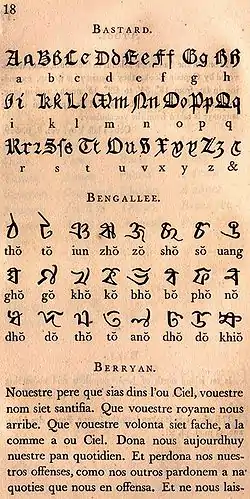Bastarda
Bastarda or bastard was a blackletter script chiefly used in France, the Burgundian Netherlands and Germany during the 14th and 15th centuries. The Burgundian variant of script can be seen as the court script of the Dukes of Burgundy. The particularly English forms of the script are sometimes distinguished as Bastarda Anglicana or Anglicana.

The early printers produced regional versions in type which were used especially to print texts in the vernacular languages, more rarely for Latin texts. The earliest bastarda type was produced by the German Gutenberg in 1454–55. The main variety was the one used in France, which was also found in Geneva, Antwerp and London. Another local variety was found in the Netherlands; Caxton's first types were a rather poor copy of this. The French lettre bâtarde passed out of use by the mid-16th century, but the German variety developed into the national Fraktur type, which remained in use until the mid-twentieth century.[1]
British typeface designer Jonathan Barnbrook has designed a contemporary interpretation titled Bastard.
See also
- Asemic writing
- Blackletter
- Book hand
- Calligraphy
- Chancery hand
- Court hand (also known as common law hand, Anglicana, cursiva antiquior, or charter hand)
- Cursive
- Hand (writing style)
- Handwriting
- History of writing
- Italic script
- Law hand
- Palaeography
- Penmanship
- Ronde script (calligraphy)
- Rotunda (script)
- Round hand
- Secretary hand
References
- A.F. Johnson, Type designs, their history and development. Third edition. (London: 1966) pp. 21–23
External links
- Fonts for Latin Palaeography, A comprehensive PDF file containing 77 pages profusely illustrated.
